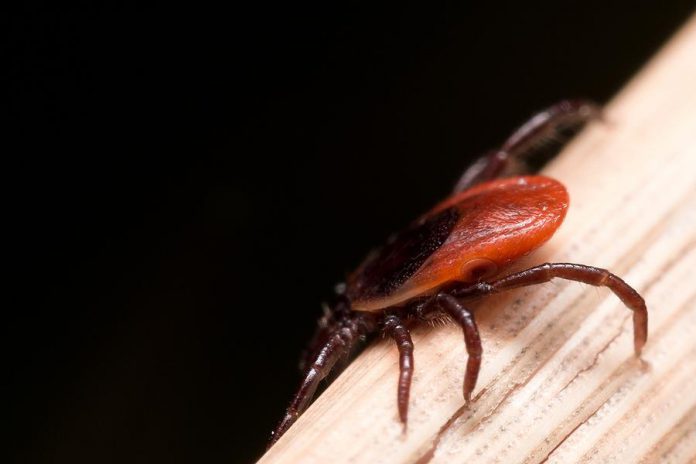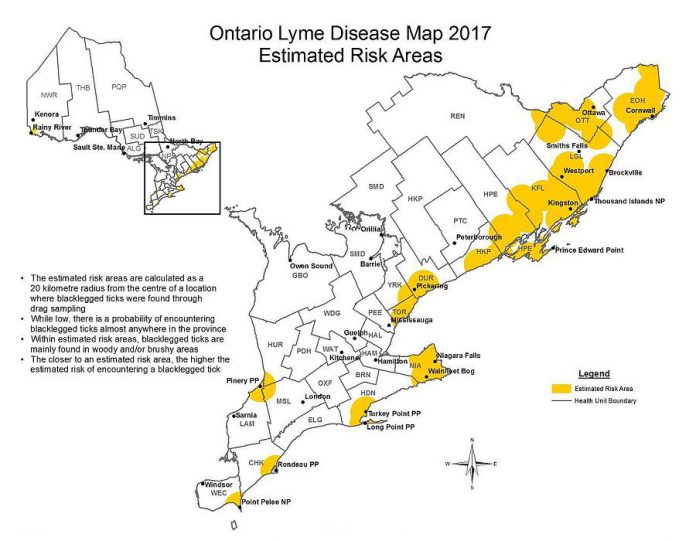
Peterborough Public Health has identified the first blacklegged tick of the season carrying Lyme disease.
“The public health lab confirmed this week that a tick submitted recently by a local resident tested positive for Lyme disease,” says Atul Jain, Manager of Environmental Health programs.
Jain notes that the precise origin of the infected tick is not known, but it is believed to have come from either southern Peterborough County or northern Northumberland County.
Peterborough Public Health is closely monitoring for evidence of other infected ticks in the area and encourages residents to submit ticks.
“Ticks can be as small as a sesame seed and their bites are usually painless,” Jain says. “So this serves as a good reminder to be on the lookout for ticks and to bring in any ticks you find on people to Peterborough Public Health for identification.”
When bringing a tick to Peterborough Public Health, only ticks found on humans will be submitted for identification and testing. Any ticks found on pets or other animals should be taken to a veterinarian.

What to do if you find a tick
If you do locate a tick on your body, use fine-tipped tweezers to grasp the tick as close to your skin as possible and pull the tick straight out.
Save the tick in an empty screw-top bottle or zipper-closed bag and take it to Peterborough Public Health at 185 King St Street in downtown Peterborough between the hours of 8:30 a.m. to 4:30 p.m. from Monday to Friday. The tick will then be sent away to a public health laboratory for identification.
When submitting a tick, you will need to provide the following information:
- The full name (including middle initial) and date of birth of the person to whom the tick was attached
- The location on the body where the tick was found
- The approximate length of time the tick was attached
- Where the tick was acquired, along with recent travel history
- A record of any symptoms experienced by the person to whom the tick was attached
- The name and city of practice of the healthcare provider of the person to whom the tick was attached.

Lyme disease is gaining the attention of health officials because cases in Ontario are increasing. In 2016, residents submitted 114 ticks to Peterborough Public Health, and of the three that tested positive for Lyme disease, one of those came from the local area. So far in 2017, 68 ticks have been submitted to Peterborough Public Health for examination, including the one that recently tested positive for Lyme disease.
Lyme disease is a potentially serious illness and growing health risk across Ontario. It is caused by the bite of infected blacklegged ticks (also known as deer ticks). While not all blacklegged ticks carry Lyme disease, populations of infected blacklegged ticks are spreading throughout Ontario. Some areas close to the areas served by Peterborough Public Health, are already considered endemic with infected blacklegged ticks.
How to prevent tick bites
The best way to prevent Lyme disease is to avoid getting bitten by ticks in areas where they live, such as tall grasses and wooded habitats. Before heading out, wear long, light-coloured clothing and tuck pant legs into socks. Spray an insect repellent containing DEET on your clothes. Check for ticks when you return from the outdoors, and it’s a good idea to shower after to wash off any ticks that may be crawling on your body.
The signs of Lyme disease can be categorized in three stages. However, the first sign is usually a circular rash in the shape of a bull’s eye. Other additional symptoms include fever, chills, headache, muscle and joint pain, fatigue and swollen lymph nodes.
For more details on precautions and symptoms of Lyme disease, visit www.peterboroughpublichealth.ca/my-home-environment/my-environment/lyme-disease/.
For more information on tick submission or general inquiries about ticks, contact the Vector-Borne Disease Program at Peterborough Public Health at 705-743-1000, ext. 240.



























